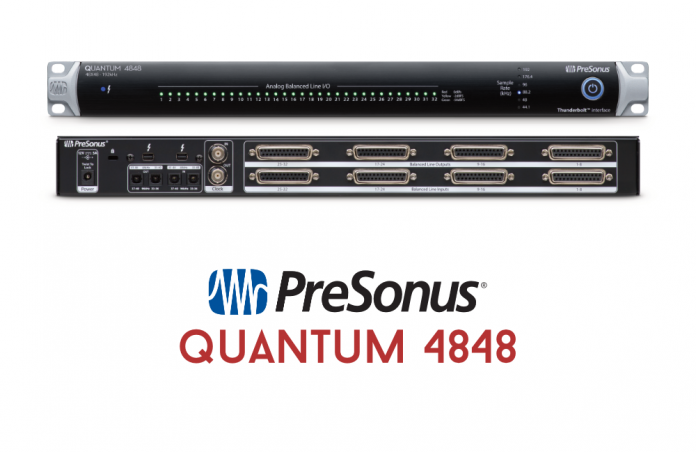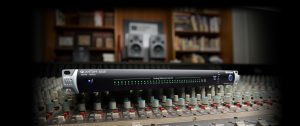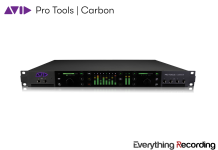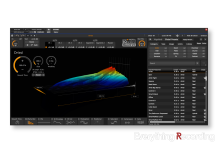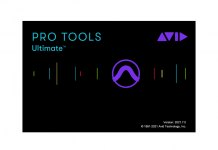Behold! The PreSonus Quantum 4848 in all its minimalist glory.
NO FRILLS. ALL THRILLS.
Twenty years ago, the Digidesign (now Avid) MBox was a milestone in the home studio DAW market. Prior to the year 2000, audio interfaces tended to be straight-ahead affairs with nothing more than line level inputs and outputs. But the MBox, with its quirky monolith form factor, bundled ProTools LE software and “designed by Focusrite” preamps gave aspiring producers a complete turnkey solution – all at the end of a single USB cable.
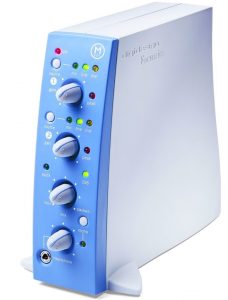
(“Remember me?” The original Digidesign MBox played a huge part in creating the “All In One” converter market.)
But in the decades since, this ‘prosumer’ category has literally exploded to dozens of manufacturers producing a myriad of all-in-one interfaces, packed to the gills with extras like mic preamps, hardware inserts, monitor control, headphone amps and expandability via optical cables. Whether you’re spending a couple hundred to get started or using it as the centerpiece of a studio, these all-in-one interfaces come in almost every shape, size, configuration and footprint.
…almost.
Not everyone with a project studio is fresh off the proverbial turnip truck. Some of us left the grind and politics of the beleaguered “big league” studio – and we still have one or several racks of gear that we’ve come to rely on over the years. That restored Telefunken V676A preamp, that old Eventide h949 that somehow keeps running, that compressor, that preamp, that processor, that eq… you get the idea. Sure, some of them have been recreated as plug-ins and while that’s all well and good, sometimes only the real thing will do(*).
*No, I am not trying to start an in-the-box vs. out-of-the-box war. Many prefer both.
Putting together a project studio with a significant amount of outboard gear can leave you pining for the converters of yore, those drab boxes without the needless perks. In fact, those “features” are really just getting in the way of what you really need, which is more i/o. To be sure, those line-only interfaces are still available… but they are aimed at the highest echelons of professional settings and as such, are not cheap.
PreSonus Takes A Quantum Leap
 (The PreSonus Quantum Range – Baby Bear, Mama Bear and Big Poppa Bear)
(The PreSonus Quantum Range – Baby Bear, Mama Bear and Big Poppa Bear)
First introduced in 2017, the Quantum range from PreSonus is designed to get pro results while still being priced attractively to newcomers and enthusiasts. They’re not alone in this range of features and prices, of course – with bigs like Focusrite, Antelope, Universal Audio, Apogee, etc. all bringing handsome desktop and rack-mount packages to market in an endless variety of configurations. But very, very few address the needs of the studio with lots of XLR-sized mouths to feed.
Then in 2019, PreSonus added the Quantum 4848 at a head-turning price of $1499.95. At first glance, it looks out of place with every other interface in the $1-2k price range. Gone are the front panel mic preamps, the headphone outputs, the guitar inputs, the monitor control… leaving nothing but a row of multicolor LEDS, a power button and a sample rate indicator
To be sure, the Quantum 4848 is here to do one job – and do it well. As the name might suggest, you get 48 channels up and down (32 analog and up to 16 more via adat optical) via a single Thunderbolt 2 connection. Users can stack up to four Quantum units for a 192-input configuration (if you need that much for your home studio, you don’t need a bigger interface, you need an intervention). Simply put, having the 32 analog inputs right out of the box is far more than you’re going to get with anything else even close to the price. Plus with 32 analog outs, you have more than enough to delve into the world of summing amplifiers or that big old analog desk you’ve been dreaming of.
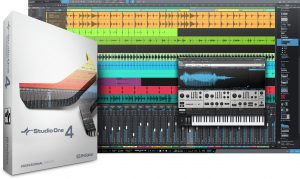
(No “lite versions” here. The professional edition of PreSonus Studio One is included.)
And if this for some reason doesn’t seem like an amazing deal, let’s not forget PreSonus includes a license to their acclaimed Studio One Professional workstation software. If you’ve been on the fence about giving this very impressive DAW a try (we’re always complaining about our existing ones, aren’t we?) you’ve got the full-blown application right in the box. Okay, it’s not actually in the box, but it is free. Additionally, there are included versions of several plug-ins from the likes of Lexicon, Klanghelm and a sweet bundle from PlugIn Alliance (Maag Audio, Brainworx, SPL and more). And yes, we’ll be taking a longer, more in-depth look at StudioOne at a later date.
Setting Up
Getting the Quantum 4848 situated was as simple as connecting a single Thunderbolt 2 cable, hopping online to get the software manager app and a quick check for any firmware updates (PreSonus is seem really on-the-ball when it comes to keeping this current). My computer, a 2018 Mac Mini (6-core 3.2gHz i7, 32GB RAM, still running Mojave as of press time) needed a single restart after installation and the two have been the bestest of pals since.
With the DB25 connectors on the rear panel, wiring in all of your outboard gear takes a bit more planning at the beginning, as you’ll need to determine what kinds of connections you’ll want to run off each of the 8-channel input and output ‘banks’. I opted to test with six DB25-to-XLR cables from Seismic Audio. Yes, you can most certainly pay more for Mogami and the like, but given the very short cable runs, I decided to go with the budget option (frankly, this was not my first Seismic Audio purchase, and I have found them to be reliably solid performers).

(Now THAT’s a lot of I/O. 32 channels analog, plus up to another 16 via Adat optical.)
The rear panel also provides the four optical connections (allowing 16 channels at 48kHz, 8 at 96kHz and 4 at 192kHz), two standard 110ohm BNC word clock connectors and a small jack for the external ‘line lump’ power supply. I did not test the Quantum with an external word clock source – nor did I hear any of the telltale signs that the clocking was unstable (this was a far bigger issue twenty years ago – and it’s fairly uncommon to see project studios using a dedicated digital clock).
By the time every last thumb-screw had been agonizingly twisted into place (packing 8 of these connectors on the rear panel is no small feat) and about 40 different connections to my preamps, monitor controller, 500 racks, processors, et. al., I fired up my DAW-of-choice, Steinberg Cubase Pro 10.5. Immediately upon launching I was asked if the Quantum 4848 was in charge now, I replied ‘yes’ and that was that.
It bears mentioning that, as you’d expect, Studio One integrates almost transparently with the Quantum series. Using Studio One’s Pipeline XT plug-in, externally routed hardware is a simple drag-and-drop affair the same as it would be for any other plug-in, with no need to fidget with sample-delays to compensate. But DAW choice aside, once you’re set up with all the appropriate routing, the Quantum’s handsome amount of ins and outs put the world back at your feet. Back over in Cubase-world, I tested all the connections, saved a template and got down to work.
Just For Reference
My previous setup prior to installing the Quantum was a Focusrite Clarett 8PreX with the venerable Apogee AD and DA16x converters running in via adat optical connections and the addition of a Switchcraft 9625 patchbay connected via DB25 cables. And while it’s true, the Apogees are most definitely not the newest converter technology, I have never once felt an urge to switch, even after demo-ing the Symphony MK2 for several weeks (I actually preferred the older converters in a blind shootout)).
A Better Kind Of Buffer
Between Thunderbolt 2’s quick-footed 20mbps data speeds and the wonderful lack of an intermediary “mix control” software layer, seeing Cubase Pro’s latency times in setup mode made me do a triple-take. At 96kHz and a 64 sample hardware buffer, the signal can go round trip from source to DAW to playback with just a skoch north of a single millisecond (1.1ms). In physical acoustics parlance, that’s like hearing the original source from about a foot away. Put another way, it’s not “negligible”, it’s basically non-existent. Even in days of yore, when going from microphone to console, console to recorder, recorder back to console and console to monitors, 2 or 3ms was more than acceptable.
A lot has been written about latency and, like many topics discussed to death online (cough, gain staging, cough cough, db luFS…) there’s an almost fanatical pursuit of getting these times to the point you’re hearing sound before it even occurs. While people have different tolerances and perceptions of this very small amount of time, most of us work can work at 128 sample buffers without noticing anything at all. Again, the physics of sound themselves are a great counterargument to this latency debate. If your monitors are two feet away, you have 2ms of latency. Two musicians in a rehearsal space stand ten feet apart, creating 10ms of latency, and manage to play in sync, do they not (this would be a good place for a drummer joke, I’m sure)?
The PreSonus website credits part of their extremely fast point-to-point performance to the following: “The Quantum driver utilizes the bus master Direct Memory Access (DMA) to transfer audio data directly to and from the main memory without using CPU processing and the overhead that would come with it.” From a technological standpoint, this makes twice the amount of sense: Allocating available computing power to where it can best be used is how the Quantum is able get the time from input to output to darn-near nil.
More importantly – how does it sound, though? All the technological whizbangery in the world doesn’t mean a wet slap if it doesn’t sound good. Judging by the following real-world tests, it would appear that PreSonus would agree.
(Probably not the best place to put your new interface. We recommend a rack.)
Enough Math. Let’s Make Music.
I started off by getting back to work on a very-behind-schedule music library project in the harder metal-type vein. With the drums for one track already about where I wanted them, I plugged my favorite shredder into my trusty Fryette Valvulator preamp, running direct into the Quantum. Just opening the volume and hitting that first drop-B open chord (DJENT!), I heard a level of detail that my previous setup comparatively “glossed over” in the 4-5k range – right where metal guitars tend to get a bit of high-shelving. It felt like I had a magnifying glass over each ear.
Switching over to bass, plugging a MusicMan Sub5 through a SansAmp pedal into a Solid State Logic E series preamp, the extreme lows (drop B means an open fifth string has a fundamental of 31hz) were ably handled, even as my subwoofer rattled books off their shelves. The lower registers came in very round and even. The first harmonic (62hz) being more important, what with it being audible and all, translated wonderfully.
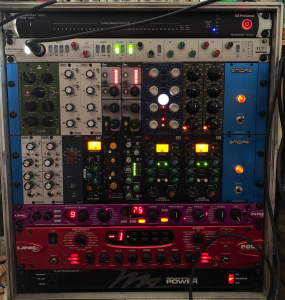
Playback from the Quantum into my main monitors (Dynaudio BM15A) was very nuanced, very crisp and had a very pointed stereo image. Reverbs felt more dimensional and far easier to place on the z-plane of distance. The Quantum’s DAC gave me a very “real” picture of where things sat, not just from left to right, but from front to back, and even behind. Of course, we have to give credit to the Dynaudio’s here, they paired nicely with the Quantum’s output.
Around And ‘Round And ‘Round It Goes
Of course, at this point I wasn’t really using the Quantum for what I need it for. What I really wanted was get deep into a mix, assigning tons of effects loops going from binary to voltage to binary and back again. Even ten years ago, the idea of taking a digital signal back into AnalogTown for a compressor or EQ would get you many a sideways look – best practices were to avoid any unnecessary A/D/A conversions – even with the best of hardware on both sides.
I started pain-testing it, first with sending the signal out and back eight times with the processor in bypass. That’s not one trip through eight processors in series, that’s eight trips there and back, there and back, there and back… The result? Couldn’t hear a difference. Literally could not hear a difference. I made some A/B WAV files and sent them to two friends for an honest blind taste test assessment. One insisted I was messing with them by sending identical files. The other guessed incorrectly – that the original source was the one who’d been through 16 conversions.
With that in mind (and ensuring my hardware latency compensation was properly engaged), I started routing individual instruments, effects busses and sub groups out into my racks, using the Quantum as a virtual patchbay. My trusty Aphex CX-1’s (an unsung 70’s hero) and Elysia nVelope went to work on the guitars and drum overheads, doing their respective bits of magic. Kick and snare went to my SSL 611DYN and EQ 500 series for their trademark thwack, slap and immediacy. The WarmAudio Bus Comp (reviewed by yours truly recently here) tackled a parallel submix on drums, while my Arsenal v14 EQ‘s breathed some life to a pair of uninspired tom close mics. Lastly, my somewhat quirky-acting GSSL was strapped across the final mix (along with my favorite Oxford Inflator VST).
That’s a lot of inserts. A lot of conversions. And more ins and outs than A Clockwork Orange. Despite the sheer amount of routing, the Quantum never felt like it was choking, smearing the phase, narrowing the stereo field or introducing any of the usual audio gremlins associated with so many trips from binary to voltage and back.
I printed audio tracks of the analog processes (unfortunately, analog has its limitations, too – and recall is one of the biggun’s. Some of my 500 series gear, wonderful as it is, lacks detented pots so the tendency is to capture the results in the moment and hope you won’t need to retrace your steps later.
An Impromptu Second Take
A good friend (and very talented bassist) dropped by to grab his standup bass, so I asked him to join me in an impromptu jam session with a very quick setup. I played a brushed snare and cajon kick with a single Mojave MA-50 placed about 3 feet away through an AML ez1081 preamp. The bass was recorded with both the piezo pickup and an SM81 pointed at the middle of the neck through two more 1081s. Lastly my trusty OktavaMod Hulk 990 was positioned about fifteen feet away from the two of us, pointed at a live wall to pick up some room reflections and run into my SSL Alpha Channel and a healthy dollop of dynamic compression from the Elysia nVelope.
Recording at 48kHz with a 32 sample hardware buffer, headphone mixes had no issue whatsoever with perceived latency. As in literally none. Many of us have found ourselves disabling plug-ins to monitor from the DAW – or using our interface’s often-clunky-or-unstable add-on control software to create direct monitoring mixes. Neither were necessary. You played a note, you heard the note. It’s really as simple as that.
After returning from our minimalist impromptu space jazz odyssey, we threw the faders up at unity, set a little bit of panning and hit play. He immediately remarked that, despite the quick and ad hoc microphone setup, the PreSonus had “a realism” he’d picked up on. The miked tracks conveyed an immediacy and a sense of literally “being there”. Though minimal it felt as if, with no additional processing either in or out of the box, what was recorded was exactly what was what you heard on playback. Score another one for the whole cast of characters here – these were all solid mics, preamps and performances – but the Quantum more-than-faithfully represented the sounds we fed it. Never once did I hear the converters adding or taking away a single thing.
On Vocals
A fun fact about me? I do voiceover work on occasion. Maybe one or two sessions a week (and a lot of auditions). The real make-or-break of any recording gear is how it handles the delicacy and nuance of the human voice and the microphones and preamps we use to record it with. True, recording a forty-something male assuring you that “Orchard Tree Bank will always be… there for you.” isn’t quite the same as tracking vocals for Adele – but it’s the human voice nonetheless.
My VO chain is a Neumann TLM103 into an AML ezAM16 preamp with just a bit of 2:1 compression from the SSL 611DYN compressor to grease it up on the way in. I was immediately satisfied with the amount of clarity the Quantum provided. It even revealed the compressor working just a bit too hard and I subsequently backed it off from a setting that’s been untouched for a year. Upper sibilant ranges came through with no slush or sear – making the chore of de-essing a breeze.
I then had a session with a female vocalist doing some tracks with an almost 90’s Portishead trip-hop kind of vibe. My tendency with this singer is to print the compression and eq on the way in, preferring to simply capture it in the analog domain exactly how it should sound in the final mix (hey, we do that with guitars ALL the TIME). But I decided to mult the input and record both the dry and affected sound. On playback I routed the dry track out through the same processing chain and tried A/B-ing the two. They were absolutely identical. Zooming in on the waveforms, you could see absolutely zero trace of difference between the two. Pulling the waveform zoom all the way up and peering into the silence between the notes? Same.
The Small Sacrifices
When you’re cramming such a sheer amount of inputs and outputs into a single rack space, there are bound to be some tradeoffs, the first of which is monitoring incoming levels. The Quantum provides a rudimentary-but-effective three stage LED for every channel. Green means go, yellow means slow and red means… well… red in digital terms is never a good thing. Meanwhile, the closest competitor in this price range, the MOTU 16A provides a monochromatic LCD display with a six-level bar graph. More detailed, but much harder to see from five feet away (especially with the grayish-blue-on-blue colors).
PreSonus gives you an additional option – you can always use the included UC Surface software, which gives you far more detailed plasma-style metering, as well as the ability to switch the front panel indicators to input or output levels (or, again, you just use your DAW’s metering).
But honestly, using your interface as a signal monitor versus your computer’s display is always a losing proposition for the hardware. Having a quick visual reference is great – but trying to pick out which of the 32 LED’s pertains to the channel in question from a distance? That’s going to be a challenge, even under the best of conditions. As my previous converters simply provided a green and red LED for each channel, I felt like using a single, multi-colored LED for each input was actually a stroke of simple genius for the PreSonus design team.
Some may bristle at the necessity of the DB25 connections. It requires the purchase of (or for the brave, the soldering of…) several snakes to interface with the outside world. At the absolute cheapest, you’re looking at about $50 for a short 8-channel snake – but as stated before, you can spend a LOT more for those super high-end Mogami twenty-footers. You should absolutely mentally add at least several hundred dollars to the price for cabling.
(Side note: The DB25 connections adhere to the Tascam DA88 pin-out. Though that’s not a true “industry standard”, it’s safe to assume that’s what your snake is unless otherwise stated. Avoid snakes that are for AES/EBU or Yamaha connections – the routing is different.)
On the plus side, this makes cable management a much breezier affair, especially if you have other units or patchbays in your rack that use this standard. And frankly, you simply can not physically fit that many TRS or XLR connections on a 1U unit – it’s not physically possible.
The Thunderbolt 2 connection is a bit of an odd duck, even just a year or so after the Quantum’s street date. Not many computers have that as a native connection. Those with Thunderbolt 1 connections can still connect, but your data speeds are still at the original Thunderbolt speed. My Mac sports Thunderbolt 3/USB3.1-C connections, meaning I had to spend $50 for a Thunderbolt 3-to-2 adapter (Apple are notorious gougers for such things) and another $20 for a 2m cable. With Thunderbolt 3 and USB-C now pretty well adopted standards, I’d love to see that change in future versions, even if USB-C offers only half the data speed (but I’m pretty sure 10MBps is up to the chore).
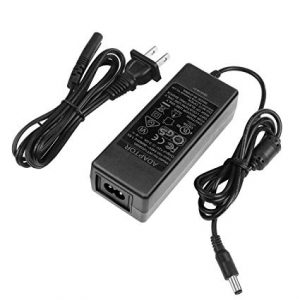
(DRAT! The dreaded line-lump!)
Lastly, and this is just a personal thing, I’m not a fan of external power supplies. It’s just a borderline obsessive-compulsive disordered preference from somebody who likes to keep the cables in the back tidy. Having 11 traditional IEC plugs and one two-piece cable with a big lump in the middle just gets in the way for color-coded zip-tie fanatics like me.
That said, none of these things are deal-breakers for me, especially when you realize just how much interface you’re getting for the price. The level metering is actually handy and is much easier to see from a few feet away. The DB25 cables, though a bit more of an investment, also offer a simplified solution to the nasty business of cable management. And the line-lump power supply? I’ll get over it.
Cornering The Market
I’ll be honest, I had my hesitations about this one. Since their original ACP88 and DCP8 units first emerged on the scene over twenty years ago, PreSonus have had a few products that I just didn’t jive with. But back then was back then and, from the looks of it, they’re going to keep becoming a bigger player in the pro audio world (I have been especially impressed with their StudioLive mixers, Sceptre monitors and Studio One DAW software). The build quality, the software and most of all, the sonics are all on a par with far more expensive alternatives.
With the exception of MOTU’s 16A, there is nothing – and I do mean nothing – new at retail even close to the $1500 mark that gives you this many inputs and outputs. As the name implies, the 16A gives you 16. And though the 4848 may be a wee bit misleading in the sense that only ⅔ of the connections are analog, expanding it with additional converters (or just buying a second unit) gives you a simply absurd amount of I/O.
The Antelope Audio Orion 32 ($2495) would be the next closest thing with regards to capability and price. And no doubt, Antelope are well-revered for the quality of their converters and bundled software. If you’re in this category, it certainly deserves an audition, even if it is priced a thousand bucks higher (and remember, you still have to buy all those DB25 cables).
Alternately, the Focusrite Red Line 16 will run you $3495 for half the inputs, and an Apogee Symphony expanded to 32×32 analog capabilities is well beyond the $7,000 range. Would I be afraid to put the Quantum against these considerably pricier competitors? Not at all. I have no doubt, having worked on almost all of the above that the PreSonus can hold its own.
The Last Word
The PreSonus Quantum 4848 offers stunningly real, bell-clear, natural and realistic A/D/A conversion with signal “round trip” times besting any other unit at its price point. You can literally convert and reconvert into the analog domain at will without sacrificing depth or quality. It’s just that good.
I get it, converters are not a fun purchase. It’s like buying cables or power conditioning. It doesn’t really “do” anything and as such, we’re reluctant to spend any more than we have to. Nobody I know is dying to show off the pristine conversion of their interface the way they would a new compressor or microphone. It’s just the nature of the beast.
On that note, you really don’t want your converter to have “a sound”. I hear them described as “fast” or “clear” or “forward” all the time. Converters are like vodka – the more you taste, the cheaper it is. What I want – and what the PreSonus delivers in spades – is an exacting replica of what you feed it. It neither gives nor takes away a single 10th of a decibel across the stated response. And with 120db of dynamic range, you really have to go out of your way to get compromised results.
For those of us who need (or simply want) to incorporate multiple points of analog processing in our workflow, the PreSonus Quantum 4848 is a no-brainer. It’s purpose-driven and a breath of fresh, simple air in a marketplace swamped with all-in-one interfaces slathered in superfluous gadgetry. If what you want is a great interface that’s content to be “just an interface” listen to the Quantum first – it might be the only one you need to hear.



